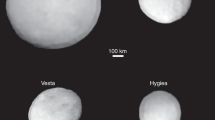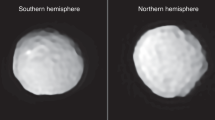Abstract
The physical characteristics of Pluto and its moon, Charon, provide insight into the evolution of the outer Solar System. Although previous measurements have constrained the masses of these bodies1,2, their radii and densities have remained uncertain. The observation of a stellar occultation by Charon in 1980 established a lower limit on its radius of 600 km (ref. 3) (later refined to 601.5 km; ref. 4) and suggested a possible atmosphere4. Subsequent, mutual event modelling yielded a range of 600–650 km (ref. 5), corresponding to a density of 1.56 ± 0.22 g cm-3 (refs 2, 5). Here we report multiple-station observations of a stellar occultation by Charon. From these data, we find a mean radius of 606 ± 8 km, a bulk density of 1.72 ± 0.15 g cm-3, and rock-mass fraction 0.63 ± 0.05. We do not detect a significant atmosphere and place 3σ upper limits on atmospheric number densities for candidate gases. These results seem to be consistent with collisional formation for the Pluto–Charon system in which the precursor objects may have been differentiated6, and they leave open the possibility of atmospheric retention by the largest objects in the outer Solar System.
This is a preview of subscription content, access via your institution
Access options
Subscribe to this journal
Receive 51 print issues and online access
$199.00 per year
only $3.90 per issue
Buy this article
- Purchase on Springer Link
- Instant access to full article PDF
Prices may be subject to local taxes which are calculated during checkout



Similar content being viewed by others
References
Null, G. W. & Owen, W. M. J. Charon/Pluto mass ratio obtained with HST CCD observations in 1991 and 1993. Astron. J. 111, 1368–1381 (1996)
Olkin, C. B., Wasserman, L. H. & Franz, O. G. The mass ratio of Charon to Pluto from Hubble Space Telescope astrometry with Fine Guidance Sensors. Icarus 164, 254–259 (2003)
Walker, A. R. An occultation by Charon. Mon. Not. R. Astron. Soc. 192, 47p–50p (1980)
Elliot, J. L. & Young, L. A. Limits on the radius and a possible atmosphere of Charon from its 1980 stellar occultation. Icarus 89, 244–254 (1991)
Tholen, D. J. & Buie, M. W. in Pluto and Charon (eds Stern, S. A. & Tholen, D. J.) 193–219 (Univ. Arizona Press, Tucson, 1997)
McKinnon, W. B. On the origin of the Pluto-Charon binary. Astrophys. J. 344, L41–L44 (1989)
McDonald, S. W. & Elliot, J. L. Pluto-Charon stellar occultation candidates: 2000–2009. Astron. J. 119, 1999–2007 (2000); Erratum. 120, 1599 (2000)
McKinnon, W. B., Simonelli, D. P. & Schubert, G. in Pluto and Charon (eds Stern, S. A. & Tholen, D. J.) 295–343 (Univ. Arizona Press, Tucson, 1997)
French, R. G. & Gierasch, P. J. Diffraction calculation of occultation light curves in the presence of an isothermal atmosphere. Astron. J. 81, 445–451 (1976)
Bartholdi, P. & Owen, F. The occultation of Beta Scorpii by Jupiter and Io. II. Io. Astron. J. 77, 60–65 (1972)
National Research Council (U.S.). International Critical Tables of Numerical Data, Physics, Chemistry, And Technology (eds West, C. J. & Hull, C.) (McGraw-Hill Book Co., New York, 1933)
Trafton, L., Stern, S. A. & Gladstone, G. R. The Pluto-Charon system: The escape of Charon's primordial atmosphere. Icarus 74, 108–120 (1988)
Yelle, R. V. & Elliot, J. L. in Pluto and Charon (eds Stern, S. A. & Tholen, D. J.) 347–390 (Univ. Arizona Press, Tucson, 1997)
Elliot, J. L., Person, M. J. & Qu, S. Analysis of stellar occultation data. II. Inversion, with application to Pluto and Triton. Astron. J. 126, 1041–1079 (2003)
Elliot, J. L. et al. The recent expansion of Pluto's atmosphere. Nature 424, 165–168 (2003)
Pasachoff, J. M. et al. The structure of Pluto's atmosphere from the 2002 August 21 stellar occultation. Astron. J. 129, 1718–1723 (2005)
Spencer, J. et al. Mid-infrared detection of large longitudinal asymmetries in Io's SO2 atmosphere. Icarus 176, 283–304 (2005)
Broadfoot, A. L., Shemansky, D. E. & Kumar, S. Mariner 10: Mercury atmosphere. Geophys. Res. Lett. 3, 577–580 (1976)
Stern, S. A. & Trafton, L. Constraints on bulk composition, seasonal variation, and global dynamics of Pluto's atmosphere. Icarus 57, 231–240 (1984)
Yelle, R. V. & Lunine, J. I. Evidence for a molecule heavier than methane in the atmosphere of Pluto. Nature 339, 288–290 (1989)
Marcialis, R. L., Rieke, G. H. & Lebofsky, L. A. The surface composition of Charon: Tentative identification of water ice. Science 237, 1349–1351 (1987)
Buie, M. W., Cruikshank, D. P., Lebofsky, L. A. & Tedesco, E. F. Water frost on Charon. Nature 329, 522–523 (1987)
Buie, M. & Grundy, W. M. The distribution and physical state of H2O on Charon. Icarus 148, 324–339 (2000)
Roush, T. L. Charon: more than water ice? Icarus 108, 243–254 (1994)
Canup, R. M. A giant impact origin of Pluto-Charon. Science 307, 546–550 (2005)
Brown, M. E., Trujillo, C. A. & Rabinowitz, D. L. 2003 EL_61, 2003 UB_313, and 2005 FY_9. IAU Circ. 8577 (2005)
Trujillo, C. A., Barkume, K. M., Brown, M. E., Schaller, E. L. & Rabinowitz, D. L. Near infrared spectra from Mauna Kea of the new brightest Kuiper Belt Object. Bull. Am. Astron. Soc. 37, 52.06 (2005)
USNO. The Astronomical Almanac for the Year 2005 (US Govt Printing Office, Washington DC, 2003)
Acknowledgements
B.A.B., J.W.G. and T.T. are Guest Observers at Instituto de Astronomía, Universidad Católica del Norte, Antofagasta, Chile. We thank N. Vogt and M. Murphy of Universidad Católica del Norte for their expertise, assistance, and the use of their telescope at Cerro Armazones; G. Gutiérrez and F. Sánchez, telescope operators at Las Campanas; R. Carrasco, K. Volk (observers), and E. Wendroth (telescope operator) at Gemini South; M. Ottoboni and R. Campos at Pico Dos Dias; and C. Czelusniak, assistant observer from Universidade Estadual de Ponta Grossa. Full credits for Gemini Observatory are available at http://www.us-gemini.noao.edu/sciops/data/dataAcknowIndex.html. Support for this work was provided by NASA Planetary Astronomy. Additional support was provided by the Belgian Federal Office for Scientific, Technical and Cultural Affairs and the Flemish Ministry for Foreign Policy, European Affairs, Science and Technology.
Author information
Authors and Affiliations
Corresponding author
Ethics declarations
Competing interests
Reprints and permissions information is available at npg.nature.com/reprintsandpermissions. The authors declare no competing financial interests.
Supplementary information
Supplementary Table
This lists the five sites from which we arranged to view the occultation of C313.2 by Charon and provides details about the observations. (DOC 41 kb)
Supplementary Discussion
This provides a complete description of how we established Charon’s radius and error bar (DOC 23 kb)
Rights and permissions
About this article
Cite this article
Gulbis, A., Elliot, J., Person, M. et al. Charon's radius and atmospheric constraints from observations of a stellar occultation. Nature 439, 48–51 (2006). https://doi.org/10.1038/nature04276
Received:
Accepted:
Issue Date:
DOI: https://doi.org/10.1038/nature04276
This article is cited by
-
Size and albedo of Kuiper belt object 55636 from a stellar occultation
Nature (2010)
-
Solar Radius Determination from Total Solar Eclipse Observations on 29 March 2006
Solar Physics (2009)
-
The New Horizons Radio Science Experiment (REX)
Space Science Reviews (2008)
-
New Horizons: Anticipated Scientific Investigations at the Pluto System
Space Science Reviews (2008)
-
Report of the IAU/IAG Working Group on cartographic coordinates and rotational elements: 2006
Celestial Mechanics and Dynamical Astronomy (2007)
Comments
By submitting a comment you agree to abide by our Terms and Community Guidelines. If you find something abusive or that does not comply with our terms or guidelines please flag it as inappropriate.



